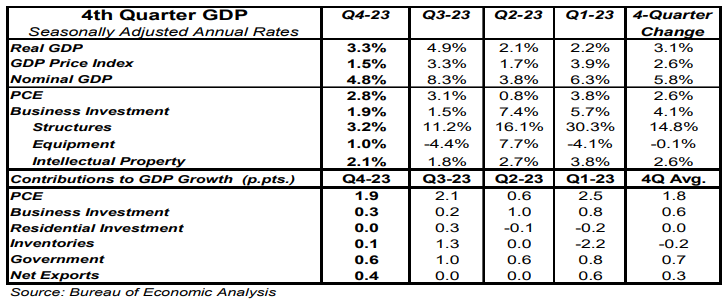- Real GDP increased at a 3.3% annual rate in Q4, easily beating the consensus expected 2.0%.
- The largest positive contribution to real GDP growth in Q4 came from personal consumption, while every other major component of GDP was up, as well.
- Personal consumption, business fixed investment, and home building, combined, rose at a 2.6% annual rate in Q4. We refer to this as “core” GDP.
- The GDP price index increased at a 1.5% annual rate in Q4 and is up 2.6% from a year ago. Nominal GDP (real GDP plus inflation) rose at a 4.8% annual rate in Q4 and is up 5.8% from a year ago.
Implications: Good news pretty much all around in the GDP report for the fourth quarter of 2023, but that doesn’t mean the risk of a recession is over. Real GDP grew at a 3.3% annual rate in Q4, well higher than the consensus expected 2.0% and higher than the forecast from any economics group. Although personal consumption accounted for most of the growth, every major component of GDP expanded and real GDP grew 3.1% in 2023, on par with the 3.2% pace we had in 2019, the year before COVID. We like to focus on “Core” GDP, which includes consumer spending, business fixed investment, and home building, while excluding government purchases, inventories, and international trade, all of which are very volatile from quarter to quarter. Core GDP increased at a healthy 2.6% rate in Q4 and was up 2.7% in 2023. Perhaps the best news was that inflation came in below expectations, with GDP prices up at a modest 1.5% annual rate in the fourth quarter, good news for both the Federal Reserve and investors. GDP prices were up 2.6% in 2023, a big improvement versus the 6.0%+ increases of each of the prior two years. Does this mean the risk of recession has passed? Hardly. The money supply declined in 2023 and that, in addition to the inverted yield curve, should eventually drag economic growth down in 2024. Meanwhile, the surge in government purchases in the past year should soon abate as the federal deficit is on an unsustainable course. In addition, businesses are unlikely to continue accumulating inventories at the fast pace of Q4. On top of that, consumer purchasing power is running into headwinds due to the depletion of COVID-stimulus related savings as well as slow growth in workers’ earnings, which, due to inflation, are barely above the pre-COVID level on an hourly basis. Nominal GDP – Real GDP plus inflation – grew 5.8% in 2023, a major slowdown from 11.9% in 2021 and 7.1% in 2022. We expect continued deceleration in 2024.





